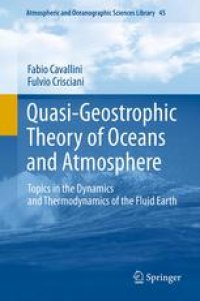
Ebook: Quasi-Geostrophic Theory of Oceans and Atmosphere: Topics in the Dynamics and Thermodynamics of the Fluid Earth
- Genre: Physics // Mechanics: Fluid Mechanics
- Tags: Oceanography, Atmospheric Sciences, Fluid- and Aerodynamics, Thermodynamics
- Series: Atmospheric and Oceanographic Sciences Library 45
- Year: 2013
- Publisher: Springer Netherlands
- Edition: 1
- Language: English
- pdf
Large-scale winds and currents tend to balance Coriolis and pressure gradient forces. The time evolution of these winds and currents is the subject of the quasi-geostrophic theory.
Chapter 1 presents concepts and equations of classical inertial fluid mechanics.
Chapter 2 deals with the equations of thermodynamics that close the governing equations of the fluids. Then, the motion is reformulated in a uniformly rotating reference frame.
Chapter 3 deals with the shallow-water model and the homogeneous model of wind-driven circulation. The chapter also describes a classical application of the Ekman layer to the atmosphere.
Chapter 4 considers the two-layer model, as an introduction to baroclinic flows, together with the concept of available potential energy.
Chapter 5 takes into account continuously stratified flows in the ocean and in the atmosphere.
Large scale flows are strong movements in the atmosphere and in the oceans, governed by the balance between Coriolis and pressure gradient forces (geostrophic equilibrium). This book describes the dynamics, mechanics and thermodynamics of these winds and currents. It is written for researchers, but also accessible for students in the field, since it also gives an overview of applied quasi-geostrophic theory suitable to advanced undergraduate and beginning graduate courses.
Chapter 1 presents concepts and equations of classical inertial fluid mechanics. Chapter 2 deals with the equations of thermodynamics that close the governing equations of the fluids. Then, the motion is reformulated in a uniformly rotating reference frame. Chapter 3 deals with the shallow-water model and the homogeneous model of wind-driven circulation. The chapter also describes a classical application of the Ekman layer to the atmosphere. Chapter 4 considers the two-layer model, as an introduction to baroclinic flows, together with the concept of available potential energy. Chapter 5 takes into account continuously stratified flows in the ocean and in the atmosphere.
Large scale flows are strong movements in the atmosphere and in the oceans, governed by the balance between Coriolis and pressure gradient forces (geostrophic equilibrium). This book describes the dynamics, mechanics and thermodynamics of these winds and currents. It is written for researchers, but also accessible for students in the field, since it also gives an overview of applied quasi-geostrophic theory suitable to advanced undergraduate and beginning graduate courses.
Chapter 1 presents concepts and equations of classical inertial fluid mechanics. Chapter 2 deals with the equations of thermodynamics that close the governing equations of the fluids. Then, the motion is reformulated in a uniformly rotating reference frame. Chapter 3 deals with the shallow-water model and the homogeneous model of wind-driven circulation. The chapter also describes a classical application of the Ekman layer to the atmosphere. Chapter 4 considers the two-layer model, as an introduction to baroclinic flows, together with the concept of available potential energy. Chapter 5 takes into account continuously stratified flows in the ocean and in the atmosphere.
Content:
Front Matter....Pages i-xiii
Front Matter....Pages 1-1
Basic Continuum Mechanics....Pages 3-41
Basic Geophysical Fluid Dynamics....Pages 43-156
Front Matter....Pages 157-157
Quasi-Geostrophic Single-Layer Models....Pages 159-244
Quasi-Geostrophic Two-Layer Model....Pages 245-272
Quasi-Geostrophic Models of Continuously Stratified Flows....Pages 273-362
Back Matter....Pages 363-385
Large scale flows are strong movements in the atmosphere and in the oceans, governed by the balance between Coriolis and pressure gradient forces (geostrophic equilibrium). This book describes the dynamics, mechanics and thermodynamics of these winds and currents. It is written for researchers, but also accessible for students in the field, since it also gives an overview of applied quasi-geostrophic theory suitable to advanced undergraduate and beginning graduate courses.
Chapter 1 presents concepts and equations of classical inertial fluid mechanics. Chapter 2 deals with the equations of thermodynamics that close the governing equations of the fluids. Then, the motion is reformulated in a uniformly rotating reference frame. Chapter 3 deals with the shallow-water model and the homogeneous model of wind-driven circulation. The chapter also describes a classical application of the Ekman layer to the atmosphere. Chapter 4 considers the two-layer model, as an introduction to baroclinic flows, together with the concept of available potential energy. Chapter 5 takes into account continuously stratified flows in the ocean and in the atmosphere.
Content:
Front Matter....Pages i-xiii
Front Matter....Pages 1-1
Basic Continuum Mechanics....Pages 3-41
Basic Geophysical Fluid Dynamics....Pages 43-156
Front Matter....Pages 157-157
Quasi-Geostrophic Single-Layer Models....Pages 159-244
Quasi-Geostrophic Two-Layer Model....Pages 245-272
Quasi-Geostrophic Models of Continuously Stratified Flows....Pages 273-362
Back Matter....Pages 363-385
....